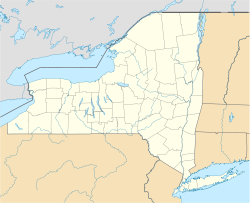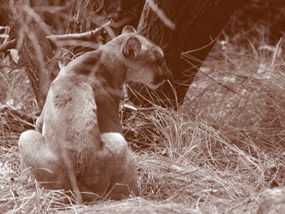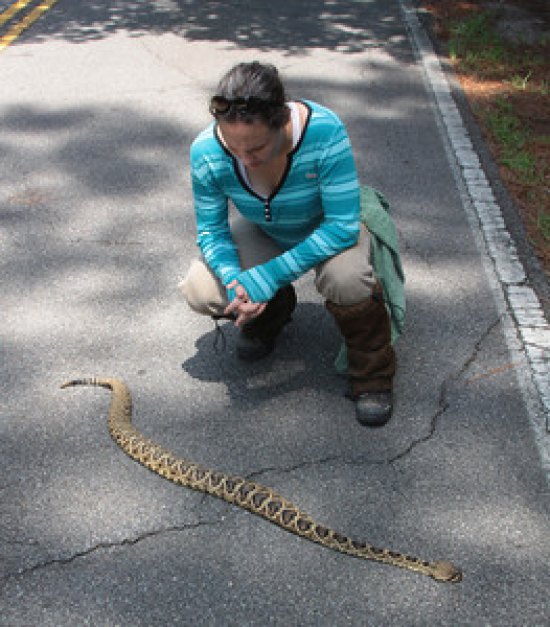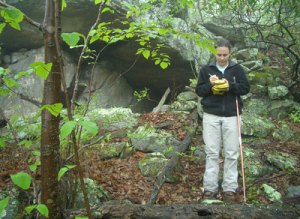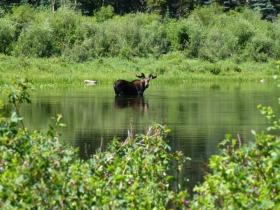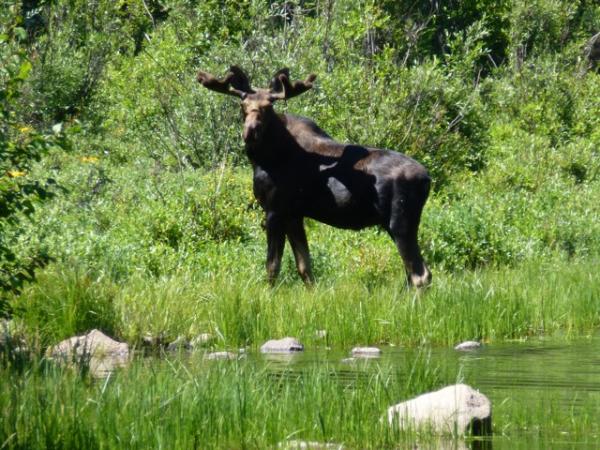Unintended results of killing older male predators
Rob Wielgus-Washingotn State University; Large Carnivore Lab
Rob Wielgus, a wildlife ecologist, started monitoring grizzly bears while in graduate school in Idaho in the early 1980s. He determined that when older males were hunted and removed from the ecological system, a social disorder resulted that threatened the survival of the remaining bears.
It didn't take him long to realize the same notion might apply to other large predators. "It looked like it was any solitary carnivore that had extended parental care," he says. He widened his focus to include cougars, black bear, and lynx.
Studying cougars in a specific area from the late 1990s until the early 2000s, Wielgus and his team of students found that while cougar sightings had steadily increased, the population, in fact, had declined at a rate of more than 10 percent per year. Hunters were going after the senior males and causing social disorder.
Wielgus's findings contradicted the common notion that increased sightings meant an increasing population. In fact, says Wielgus, it's the opposite. An older male will protect his territory, do his best to stay out of view, and preserve a social order that provides his mates the years they need to raise their kittens. If he's gone, juvenile males will move in and kill his kittens, further reducing the population, particularly damaging the female population. Without an older male to keep them in check, in their new territory the juveniles will also chance more human and livestock encounters.
Instead of thinking the killing of a Carniovre as an accomplishment, it should be seen as a felony
This work has changed hunting and wildlife management policies in the United States and Canada. At one time governments allowed for more hunting when there was an increase in human-cougar or human-bear encounters. Now in Washington, Oregon, and British Columbia the hunting of these large predators has been restricted. Based on Wielgus's findings, British Columbia has created seven grizzly bear preserves.
These hunters have to be reindocrinated to come to see that Carnivore killing
should not be part of the "gun & bow" mission each Fall
Wielgus directs the Large Carnivore Conservation Lab at WSU with the mission of helping maintain healthy predator/prey communities in the Pacific Northwest and around the world. He and his students and post-docs have studied cougars in the Washington, grizzlies in British Columbia, and brown bears in Europe. Now his students and other researchers who have studied his work are noting how this same behavior applies to large predators world-wide, including leopards, tigers, and cheetahs.
----------------------------------------------------------------------------------------
Predator management by state wildlife agency biologists questioned.
by GEORGE WUERTHNER ;thewildlifenews.com
I recently had encounters with three state wildlife agency biologists. All of them were quite open with their criticisms of their agencies predator policies. I can't reveal their names and I will change a few details to hide their identities.
The first biologist told me there was no reason to kill predators. He said it only creates greater social chaos which in turn leads to more unnecessary killing. He told me that increasing the kill of predators by hunters—whether cougars or wolves—seldom reduced conflicts. If it's good habitat, the vacuum created by killing a cougar or a wolf pack will soon be filled by immigrants. So in the end livestock operators have to learn to discourage predation by practicing good animal husbandry. Predator killing just doesn't work.
"Fladry(red flagging) is one of the tools to keep Wolves from livestock
Another reason predator control fails is that most hunters pursue animals that live on the larger blocks of public land, while most of the conflicts occur on the fringes of towns or on private ranch lands. In other words, the majority of cougars and wolves killed by hunters are animals that are not causing any conflicts.
He went on to say that hunting predators had no benefits. Period.
The second biologist told me that wolves were not harming elk and deer herds. Rather elk and deer populations have increased in the state since wolves were introduced. He pointed out that wolves were also not destroying the livestock industry though he did acknowledge that individual ranchers might be challenged by wolf depredations.
Fladry keeping Wolves from sheep
He also reiterated that hunting predators was indiscriminate. The specific predator killing a rancher's livestock is often not the animal killed by hunters so arguing that killing predators will reduce conflicts is at best a half truth.
The third biologist told me that his agency missed the boat by not responding to the misinformation from the Rocky Mountain Elk Foundation and Toby Bridges of Lobo Watch. By not countering the distortions put forth by these organizations, fabrications and half-truths were widely distributed by the media.
He also acknowledged that wolves could not increase indefinitely. They expand their range into new territories but their densities are socially maintained. In other words, you will not get more and more wolves living in the same basic area. He said people have to learn to live with natural processes which include predation.
What these encounters demonstrate to me is that many biologists working for these state agencies are sympathetic to predator supporters. They are muzzled by their agencies and unable to speak the truth. Still it is refreshing to know that supporters of predators have some friends within state agencies—biologists who are hoping that legal attempts to stop unnecessary and indiscriminate hunting and trapping will succeed.
Guard Dogs is another Wolf and Puma deterrent in livestock protection
This also means that citizens and those who support predators have to create the political space where these biologists can feel free to speak their minds. Keep up the pressure, there are some in these state wildlife agencies who know the score, and are as devoted to wildlife as anyone.
About George Wuerthner
Mr. Wuerthner is an ecologist, writer and photographer who also teaches field ecology classes, photo workshops and guides natural history tours through his company, Raventrails.George has researched and written a number of books on mountain ranges, wilderness areas and parks, exploring hundreds of ranges from New Mexico to Alaska. He has visited more than 380 wilderness areas and hundreds of national parks. In particular, he is very knowledgeable about Alaska and has visited all the national parks, preserves and major wildlife refuges in that state.
George has written 35 books on the national parks, conservation issues, wilderness areas, mountain ranges and wildlife issues, including titles for the National Park’s Visitors Companion Series on the Rocky Mountains, Oregon’s Wilderness Areas, Yellowstone National Park, Mount Rainier, the Grand Canyon and the Great Smoky Mountains. He is also the author of Thrillcraft: the Environmental Consequences of Motorized Recreation, and has released numerous books of his wilderness photography.
Mr. Wuerthner worked as a wilderness guide and instructor for the University of Montana Outdoor Program, as a river ranger/biologist on the Fortymile River in Alaska, as a backcountry ranger in the Gates of the Arctic National Park, a surveyor for the Bureau of Land Management in Alaska, a botanist/biologist for the B.L.M. in Idaho, He also regularly guided wilderness trips in the Rocky Mountains and in Alaska.
------------------------------------------------------------------------------
MANASSAS
"Isn't It About Time"
Isn't it about time
Isn't it about time we learned
Isn't it about time
Isn't it about time we learned
Fire, flood, familiar, famine
The jungle so far away
Blood baked into blackened soil
How many tons a day
Isn't it about time
Isn't it about time we learned
Isn't it about time
Isn't it about time we learned
Isn't it about time
Isn't it about time we learned
Isn't it about time
Isn't it about time we learned
Why, does it take so long
Is it easy not to care
Seems to me that enemies are fantasies
Somebody else's living nightmare
Who gonna live, who gonna die
Do you want to know
Does it give you a sense of power
To say yes or no
Isn't it about time
Isn't it about time we learned
Isn't it about time
Isn't it about time we learned
Isn't it about that time
Isn't it about time we learned
Isn't it about time
Isn't it about time we learned
Isn't it about time
Isn't it about time we learned
Isn't it about time
Isn't it about time we learned
Isn't it about time we learned
Isn't it about time
Isn't it about time we learned
Fire, flood, familiar, famine
The jungle so far away
Blood baked into blackened soil
How many tons a day
Isn't it about time
Isn't it about time we learned
Isn't it about time
Isn't it about time we learned
Isn't it about time
Isn't it about time we learned
Isn't it about time
Isn't it about time we learned
Why, does it take so long
Is it easy not to care
Seems to me that enemies are fantasies
Somebody else's living nightmare
Who gonna live, who gonna die
Do you want to know
Does it give you a sense of power
To say yes or no
Isn't it about time
Isn't it about time we learned
Isn't it about time
Isn't it about time we learned
Isn't it about that time
Isn't it about time we learned
Isn't it about time
Isn't it about time we learned
Isn't it about time
Isn't it about time we learned
Isn't it about time
Isn't it about time we learned
Down The Road 1973










